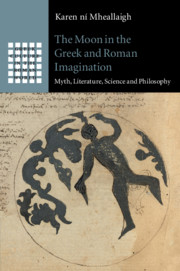Book contents
- The Moon in the Greek and Roman Imagination
- Greek Culture in the Roman World
- The Moon in the Greek and Roman Imagination
- Copyright page
- Dedication
- Contents
- Acknowledgements
- Abbreviations, Text References and Translations
- Part I The Moon in the Mythic Imagination
- Part II The Moon in the Scientific Imagination
- Part III The Moon in the Fantastic Imagination
- Chapter 5 The Imaginary Moon
- Chapter 6 Selēnoskopia
- Envoi
- Bibliography
- Index
- Index Locorum
Envoi
The Legacy of Ancient Selenography
from Part III - The Moon in the Fantastic Imagination
Published online by Cambridge University Press: 09 October 2020
- The Moon in the Greek and Roman Imagination
- Greek Culture in the Roman World
- The Moon in the Greek and Roman Imagination
- Copyright page
- Dedication
- Contents
- Acknowledgements
- Abbreviations, Text References and Translations
- Part I The Moon in the Mythic Imagination
- Part II The Moon in the Scientific Imagination
- Part III The Moon in the Fantastic Imagination
- Chapter 5 The Imaginary Moon
- Chapter 6 Selēnoskopia
- Envoi
- Bibliography
- Index
- Index Locorum
Summary
In the Introduction to the book, I promised a symphonic story of lunar thought. I hope, by now, that the reader has come to hear the interconnected harmonies of ancient selenography: how ideas about the Moon as a goddess resurface in the fantastical, querulous Moon of Lucian’s Icaromenippus; how beliefs about the Moon’s moisture and liquescence swell, in Lucian’s hands, into a world of corporeal and political viscosity; how the Moon’s ancient anthropomorphization as a goddess becomes rationalized, in Plutarch’s work, into connections with birth and death; and how the ancient ocular intensity of the Moon makes it into a site for visual science and fantasy.
- Type
- Chapter
- Information
- The Moon in the Greek and Roman ImaginationMyth, Literature, Science and Philosophy, pp. 291 - 294Publisher: Cambridge University PressPrint publication year: 2020

